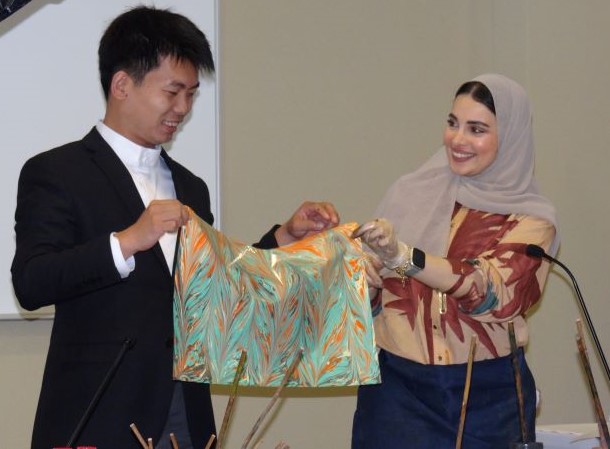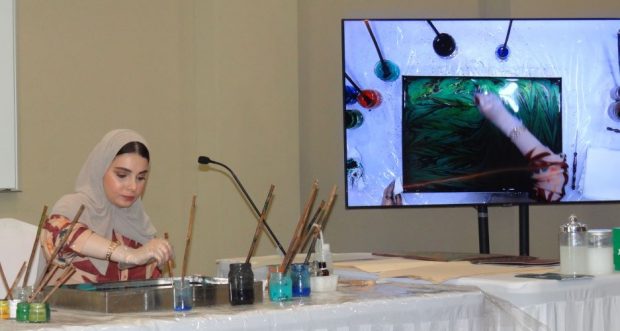How much sacrifice does it take to become an artist?

Maryam interacting with a participant at Fujairah Al Bader Festival after he tied his hands at ebru and created something unique and beautiful
FUJAIRAH: How much sacrifice does it take to become an ebru artist? Ask Maryam Al Tamimi, the ebru art artist, and she will respond with a large contagious smile and “A lot! But it is worth it.”
Maryam was a student at a university in the United Arab Emirates (UAE). She attended her classes regularly, but every weekend, she took the plane to Istanbul, Turkey, where she was gaining insights into the fascinating world of ebru. The flight of more than 3,000 kilometers lasts five hours.
“I did that for years, as I was so compassionate about acquiring the necessary skills for the art and completing my apprenticeship,” she says.
“I worked on my college homework and assignments at airports waiting for my flights. On board, it was not in-flight entertainment, but in flight-studies. Very demanding and very costly, but it was worth it.”
Ebru is the traditional Turkish art of creating colorful patterns by sprinkling and brushing color pigments onto a pan, or ‘tekne’, of Tragacanth Gum and water solution. A prepared mixture of paint and ox bile is then dropped in the viscous water, and in turn floats on top of it. Completed, the paper is placed carefully in the pan to absorb the fluid composition.
Known as marbling, the designs and effects include flowers, foliage, ornamentation, latticework, mosques and moons, and are used for decoration.
Maryam shared her skills at a workshop dedicated to ebru at the second edition of Al Bader Festival in Fujairah, one of the seven emirates composing the UAE.
The annual festival celebrates arts, cultural and heritage while commemorating the birth of Prophet Mohammed, known in Arabic as “Mawlid”.
The festival, under the patronage of Fujairah Crown Prince Sheikh Mohammed bin Hamad Al Sharqi, has brought together calligraphers, painters, religious chant performers and artists from several countries to celebrate the Mawlid and to propagate peace, tolerance, mutual acceptance, compassion and coexistence as the leading values that must guide the world.

Maryam during her workshop
In her interaction with the audience at the workshop, Maryam demonstrated how to use ox bile, which prevents the mixing of colors, and combine it with colors derived from natural materials to paint on acid-free chamois papers.
The papers are placed on the water with the addition of gum to produce artistic paintings based on sophisticated aesthetic sense.
Maryam said that Ebru is one of the ancient arts that were widespread in Turkey and Persia, and that it was used for book covers and patchwork decorations, although, recently, it is being used to decorate calligraphic paintings.
“A very pressing purpose for me now is to pass on the art of ebru to as many people as possible. I want to see young people take up ebru as an art. A truly beautiful art.”
To Maryam who has tremendously evolved with ebru, ebru is much more than a craft, a technique or a skill. It is a way of life.

























































